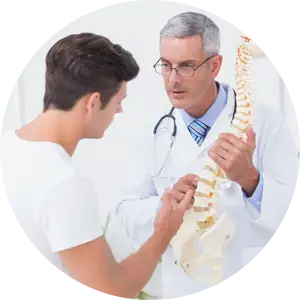Low back pain is something 80% of people will experience at some point in their life. What’s even crazier is it is actually the number one cause of disability in the US. When most people think about back pain, the first thought that usually comes to mind is that a muscle tweak, poor posture, or sleeping in the wrong position caused it. This might be true in some cases, but a lesser known yet equally common cause of low back pain is a disc injury.
Our spinal discs sit between each of the bones in your spine. They are kind of like a jelly donut. The fibrous outer shell is like the crust, and the fluid center is like the jelly. Discs, like most tissue in your body, wear down and become dehydrated over time which causes the outer fibers of the disc to tear. This allows the jelly center to push on the disc’s most worn down and weakest points, potentially pushing right through the disc’s outer wall. This is called a disc herniation. A herniation is typically the beginning early stage of most disc injuries. As time progresses, an injured disc will wear down even further, and the tear will get wider. That means more of the jelly is going to bulge out. Unsurprisingly, the medical term for this is a disc bulge.



